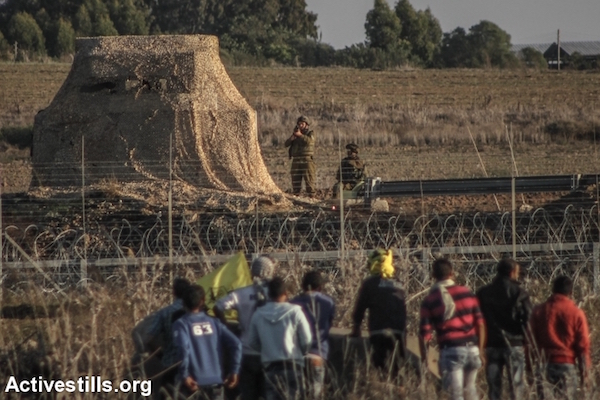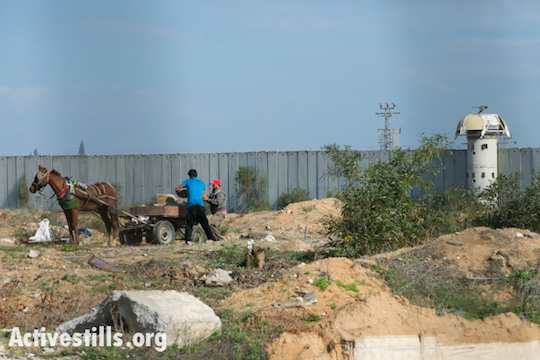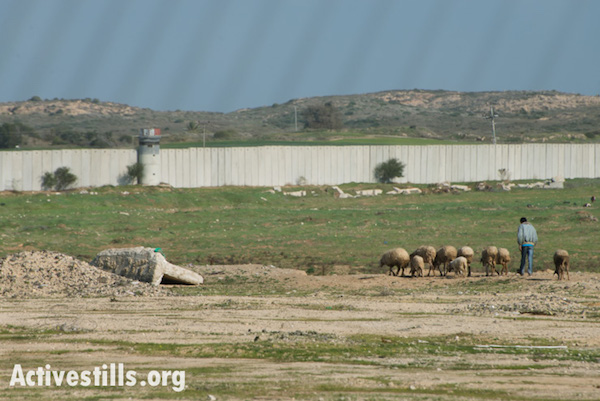The army says aerial spraying was meant to ‘enable security operations.’ Palestinian farmers say hundreds of acres of crops were damaged or destroyed.

The Israel army has confirmed that it used crop-dusters to kill off vegetation — and perhaps inadvertently, agricultural crops — inside the Gaza Strip last week. According to Palestinian officials, over 420 acres of land were damaged by the spraying.
For years now, the IDF has unilaterally maintained a lethal “no-go zone” on the Palestinian side of the border with Gaza. Now, it seems, it has also implemented a “no-grow zone.”
“The aerial spraying of herbicides and germination inhibitors was conducted in the area along the border fence last week in order to enable optimal and continuous security operations,” an IDF Spokesperson told +972 on Sunday.
Palestinian Agricultural Ministry officials told Ma’an news that farmers said Israeli planes had been spraying their agricultural lands adjacent to the border fence for several days straight. Spinach, pea, parsley and bean crops were reportedly destroyed around the al-Qarrara area in eastern Khan Younis and the Wadi al-Salqa area in central Gaza, according to the report.
The military spokesperson did not respond to a follow-up question about the destruction of agricultural crops.
The spraying of herbicides in Gaza was not reported in the Israeli media.

The IDF has for years imposed a lethal no-go buffer zone along the Gaza border. The army killed at least 16 Palestinians and wounded at least 379 more who entered or approached the no-go zone in recent months, most of whom were participating in demonstrations along the fence.
Farmers and scrap collectors are also regularly targeted as they approach the fence. Palestinians often claim that those shot were outside the restricted area. Rarely are there any allegations that those shot were armed.
“Spraying crop-killing pesticides, like opening fire at people of all ages and gender in the vicinity of the fence, puts civilian lives at risk and hurts livelihoods,” said Shai Grunberg, spokesperson for Gisha, an Israeli rights group that works to promote freedom of movement for Palestinians in Gaza. “By virtue of Israel’s substantial control of the Gaza Strip, international law requires it to facilitate normal life in the Strip.”
From an Israeli military perspective, the buffer zone helps the army counter the laying of IEDs, ambushes and border infiltrations. Ground forces regularly enter the Strip in order to clear obstructions to army’s line of sight, including by demolishing structures and trees. The logic behind the herbicidal clearing of foliage and crops along the border area, one can assume, is to clear a line of sight for soldiers seeking to identify threats.

The Israeli army has provided contradictory information regarding the no-go zone over the years, including the area’s specific size and its procedures for engaging (shooting at) civilians who enter it for various reasons. From explanations given in recent months, it appears that the no-go zone stretches 300 meters from the fence but that farmers are allowed to approach up to 100 meters by foot. Those distances tend to differ from area to area, according to Gisha.
The army has not disclosed how it distinguishes between farmers and other civilians, or civilians and combatants, however.
“A primary principle of international humanitarian law is the distinction between combatants and civilians,” Israeli human rights group B’Tselem wrote in a report on the no-go zone in Gaza. “When it is unclear if the persons are civilians or combatants, they must be treated as civilians.”

During the Vietnam war, the United States famously sprayed Agent Orange, napalm and other herbicides and defoliants to destroy vast swathes of jungle in Vietnam for military purposes. After the health and environmental effects such practices became clearer, however, the international community initiated the Environmental Modification Convention restricting the use of herbicidal warfare, which came into force in 1978. Israel is not a party to the convention.
In addition to enforcing a lethal buffer zone along its land border with Gaza affecting Palestinian farmers, the Israeli army also imposes strict, and sometimes deadly restrictions on the maritime areas in which Palestinian fisherman may fish.
Israel withdrew its troops from the Gaza Strip 10 years ago but its military still controls its land and sea borders, airspace, maritime zone, population registry, and decides which people and what goods may enter and exit the Strip. While Gaza also has a land border with Egypt, the Rafah crossing is a passenger terminal only, is often closed, and only lets through a limited number of people.
Correction: This article originally included outdated statistics on the relative size of Gaza’s “no-go zone” as a percentage of the entire territory. That sentence has been removed.
Haggai Matar contributed to this report.


